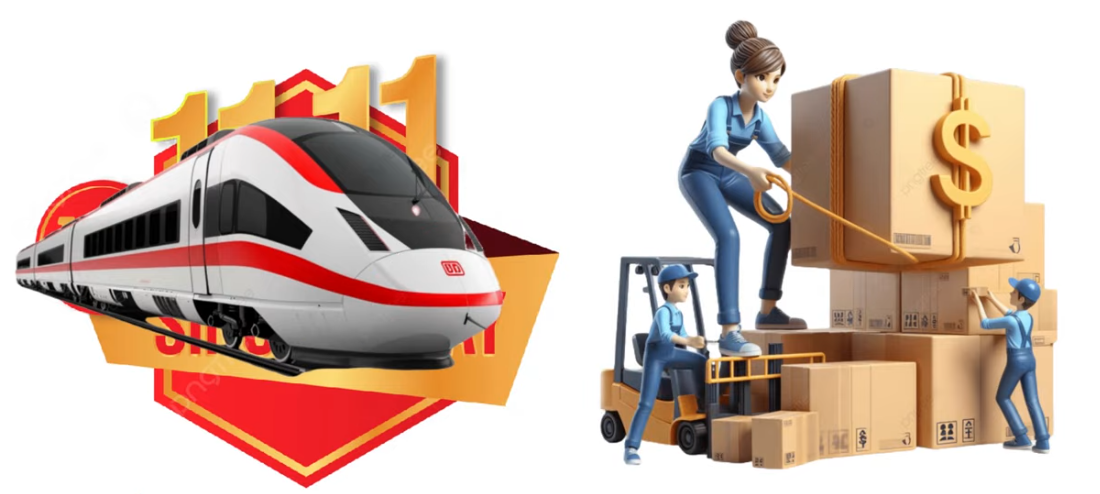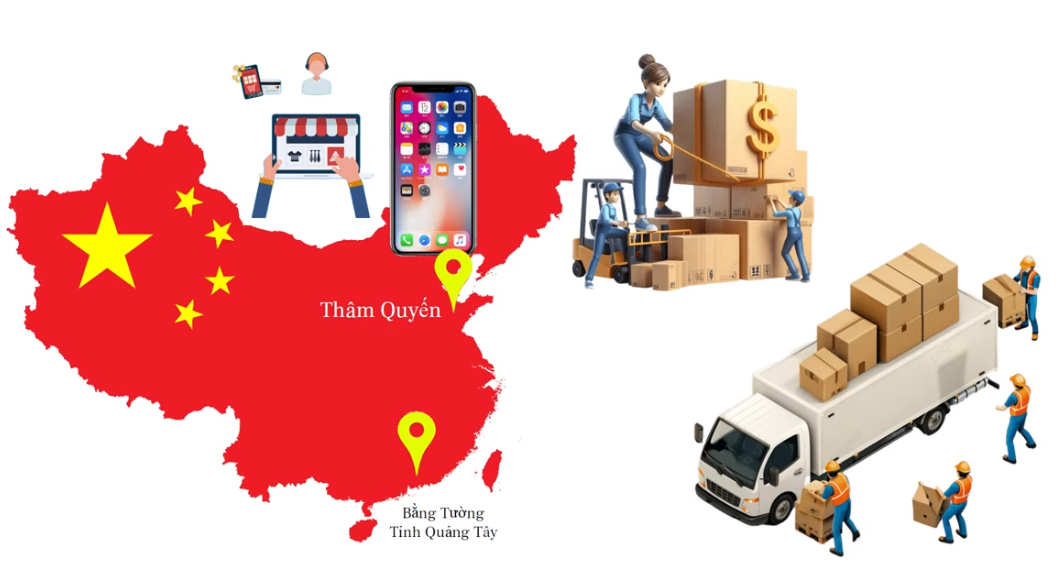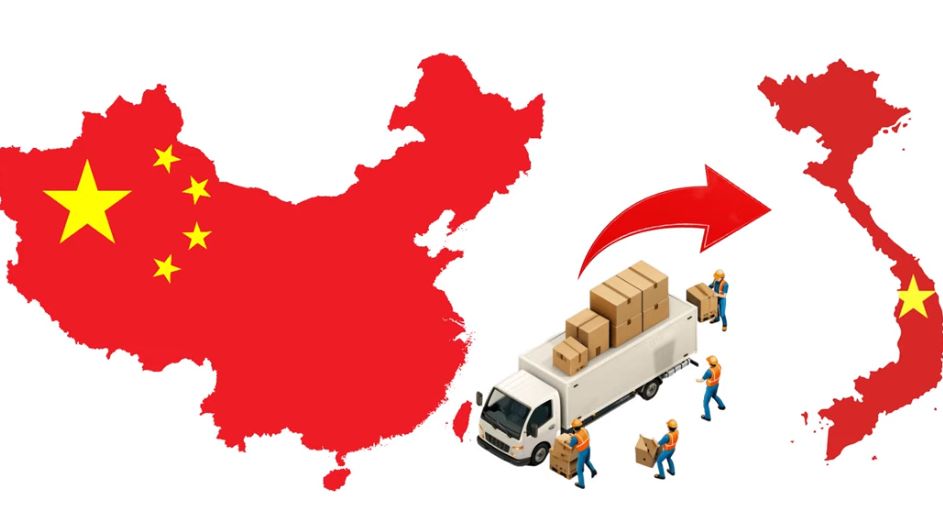Let's explore China's logistics network to better understand how they can deliver goods quickly to Vietnam and many other places around the world.
How massive and modern is this network? First, we must mention the ultra-high-speed rail system of domestic transportation. China has heavily invested in the high-speed rail system, making it the backbone of domestic transport. By 2023, China had over 40,000 km of high-speed rail connecting major cities like Beijing, Shanghai, Guangzhou, and Shenzhen. Imagine ordering an item from Shanghai in the morning; the goods could be transported to Beijing by the afternoon of the same day thanks to this high-speed rail system, covering a distance of thousands of kilometers in just 4 to 5 hours.
A very specific example is during the Singles' Day, the largest shopping event in the world, orders in Beijing can be delivered to Guangzhou, about 2200 km away, in less than 24 hours thanks to dedicated freight high-speed trains. And what about the world? China has the largest export ports in the world and is home to many of the largest ports globally, with the ports of Shanghai and Shenzhen playing crucial roles in exporting goods. For instance, the Port of Shanghai is the largest cargo export port in the world, handling 47 million containers in 2022. This means that the port processes an average of about 128,000 containers each day.

When an electronic container is produced in a factory in Shenzhen, it can be transported to the Port of Shenzhen within a few hours and then forwarded to the Port of Haiphong, Vietnam, within 2 to 3 hours. Not only that, the Ningbo Zhoushan Port near Hangzhou is another giant in the maritime transport industry. From here, goods can be transported to Vietnam via Cai Mep Port in Vung Tau within 4 to 5 days, depending on the shipping route and weather conditions.
With transportation in place, there must also be inventory; the warehousing system is also very important.
The warehousing system in China is not only large but also highly automated, exemplified by the warehouses of jd.com and Alibaba. For example, jd.com has a fully automated warehouse in Shanghai, equivalent to 24 football fields. Here, robots can automatically sort, package, and prepare goods for delivery without human intervention. During major shopping events like Singles' Day, this warehouse can handle up to 1 million orders per day, and goods can be shipped out within just a few hours after the order is placed. Another example is Alibaba's smart warehouse system in Hangzhou. Here, AI technology is used to manage the warehouse and coordinate the transport of an order, which can be processed and shipped within 30 minutes after being received, significantly reducing delivery time to the end user.
China's road system also plays an important role in the rapid transportation of goods. With over 160,000 km of highways, goods can easily move from manufacturing plants to seaports or borders. For example, a truck carrying goods from the Guangzhou industrial zone, one of China's largest manufacturing centers, can reach the Huu Nghi border gate in Lang Son in just about 12 to 14 hours. This is particularly important for shipments that need to be delivered urgently or to meet sudden demands from Vietnamese partners. Another case is fresh fruit shipments from Yunnan, China, to Hanoi.

This transportation process takes less than 24 hours thanks to the modern road system, ensuring that goods remain fresh when they reach consumers. For high-value or urgent orders, air transport is available. China currently has over 200 civil airports, with major international airports like Beijing, Shanghai, and Guangzhou serving as key air transport hubs. For example, an order for electronic equipment to Shenzhen can be sent to Baiyun International Airport in Guangzhou and then fly directly to Noi Bai within about 4 to 5 hours. When combined with efficient customs processes, the entire process from ordering to receiving takes only 2 to 3 days, a speed that is hard to match elsewhere.
Now, let's consider a specific example to illustrate how goods from China can quickly reach Vietnam thanks to their warehouses and rapid transportation, especially a warehouse near the border. For instance, you are ordering a phone from Shopee in China. You are purchasing a phone from a seller on Shopee based in Shenzhen, for example. Instead of shipping this phone directly from Shenzhen, which is a long distance, the seller has the goods available at a warehouse in Bằng Tường, Guangxi, close to the Huu Nghi border gate.
On the first day after you place the order, the order is processed immediately; the goods are already available at the Bằng Tường warehouse, so it only takes 2 to 3 hours for checking and repackaging if necessary. That is step one; once step one is completed, it moves to step two: transporting from the warehouse to the Huu Nghi border gate. After completing the packaging, the goods are transported from Bằng Tường to Huu Nghi, a very short distance of about 2 to 3 hours by truck. Therefore, on the same day, the goods arrive at the border gate and are ready for customs clearance. Thus, on the second day, the goods have passed through the Huu Nghi border gate and are imported into Vietnam after just a few hours of customs processing, thanks to the rapid electronic customs clearance process. Step three is transporting from the border gate to you after the goods pass through the border gate.
It will be delivered to Shopee's distribution center in Hanoi, with the distance from Huu Nghi border gate to Hanoi being only about 160 km, taking about 4 to 5 hours by truck. From the Hanoi distribution center, your order is delivered to your home on the same day or, at most, the next day, depending on the delivery address. So, at the earliest by the third day, you have received the phone you ordered from a seller on Shopee. Thanks to the goods being pre-stocked at a warehouse near the border, specifically in this case at Bằng Tường, the transportation process becomes extremely quick.

The short distance from the warehouse to the border gate saves a lot of time, and the quick customs clearance at the Huu Nghi border gate allows goods to reach you in just a few days, thanks to warehouses near the border and modern transport routes. Chinese goods can reach neighboring countries like Vietnam very quickly, even when international deliveries to Europe or the US are also very competitive compared to other systems. China's logistics network is a modern marvel, with each component from high-speed rail, seaports, warehousing, transportation, roadways, to air transport operating in harmony and efficiently.
